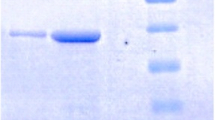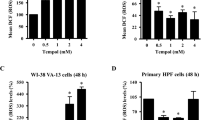Abstract
Treatment of A549 human lung carcinoma cells with L-buthionine-[S,R]-sulfoximine (BSO) results concomitantly in cellular glutathione (GSH) depletion and growth inhibition. The nature of BSO effects on cell growth and the relationships between BSO inhibition of cell growth and BSO effects on cellular GSH levels were determined in this study. A dose dependent effect of BSO on cell growth was observed, but this effect was found not to correlate with BSO effects on cellular GSH levels. Treatment with BSO for 60 h at concentrations of 5 and 10 mM was found to deplete cellular GSH at similar rates and to an undetectable level (below 0.5 nmol/mg protein). However, cessation of growth occured in 10 mM BSO whereas growth continued at better than one half the control rate in 5 mM BSO. The results suggest there may be a distinct threshold level of intracellular G GSH (on the order of or less than 0.5 nmol/mg protein) required for cell growth and for cells to protect themselves from the antiproliferative effects of BSO. At a concentration of 10 mM, BSO inhibited both DNA and protein synthesis and arrested growth of A549 cells throughout rather than at a specific phase of the cell cycle. BSO inhibition of growth was not, as indicated by colony-forming efficiency (CFE) and electron microscopy studies, accompanied by indications of cytotoxic effects. A stimulatory effect of 0.1 mM BSO on the growth of A549 cells was found also.
Similar content being viewed by others
Abbreviations
- BSO:
-
L-buthionine-[S,R]-sulfoximine
- GSH:
-
Glutathione (reduced form)
- GSSG:
-
Glutathione disulfide
- DTNB:
-
5,5′-dithiobis (2-nitrobenzoate)
- PBS:
-
Phosphate buffered saline
- BSA:
-
Bovine serum albumin
- PI:
-
Propidium iodide
- CFE:
-
Colony-forming efficiency
- EM:
-
Electron microscopy
References
ALLISON, D.C., BOSE, K.K., ANDERSON, S., and ROBERTSON, J. (1989). Slowing of cell in exponential monlayer cultures placed into plateau-fed and starved medium. Cancer Res. 49: 1456–1464.
ALLISON, D.C., ANDERSON, S., RIDOLPHO, P.F., MEYNE, J., and ROBERTSON, J., (1986). Alteratations in the DNA metabolism of MCa-11 mouse mammary tumor cells grown in vivo and in vitro. Cancer Res. 46: 3951–3957.
BRODIE, A.E., and REED, D.J. (1985). Buthionine sulfoximine inhibition of cystine uptake and glutathione biosynthesis in human lung carcinoma cells. Toxicol. Appl. Pharmacol. 677: 381–387.
CLARK, E.P., BPP, E.R., BIAGLOW, J.E., MORSE-GANDRO, M., and ZACHGO, E., (1984). Glutathione depletion, radio-sensitization, and misonidazole potentiation in hypoxic Chinese hamster ovary cells by buthionine sulfoximine. Radiat. Res. 98: 370–380.
CRISSMAN, H.A., and STEINKAMP, J.C. (1982). Rapid, one step staining procedures for analysis of cellular DNA and protein by single and dual laser flow cytometry. Cytometry 3: 84–90.
DETHMERS, J.K. and MEISTER, A. (1981). Glutathione export by human lymphoid cells: depletion of glutathione by inhibition of its synthesis decreases export and increase sensitivity to irradiation. Proc. Natl. Acad. Sci. USA 78: 7492–7496.
FISCHMAN, C.M., UDEY M.C., KURTZ, M., and WEDNER, H.J. (1981). Inhibition of l lectin-induced lymphocyte activation by 2-cyclohexene-1-one: decreased intracellular glutathione inhibits an early event in the activation sequence. J. Immunol. 127: 2257–2262.
GREEN, J.A., VISTICA, D.T., YOUNG, R.C., HAMILTON, T.C., ROGAN, A.M., and OZOLS, R.F. (1984). Potentiation of melphalan cytotoxicity in human ovarian cancer cell lines by glutathione depletion. Cancer Res. 44: 5427–5431.
GRIFFITH, O.W. and MEISTER, A. (1979). Potent and specific inhibition of glutathione synthesis by buthionine sulfoximine (S-n-butyl homocysteine sulfoximine). J. Biol. Chem. 254: 7558–7560.
HAMILOS, D.L., ZELARNEY, P., and MASCALI, J. (1989). Lymphocyte proliferation in glutathione-depleted lymphocytes: direct relationship between glutathione availability and the proliferative response. Immunopharmacology 18: 223–235.
HAMILOS, D.L. and WEDNER, H.J. (1985). The role of glutathione in lymphocyte activation I. Comparison of inhibitory effects of buthionine sulfoximine and 2-cyclohexene-1-one by nuclear size transformation. J. Immunol. 135: 2740–2747.
KANG, Y.-J. and ENGER, M.D. (1987). Effect of cellular glutathione depletion on cadmium-induced cytotoxicity in human lung carcinoma cells. Cell Biol. Toxicol. 3: 347–360.
KANG, Y.-J. and ENGER, M.D. (1990). Glutathione content and growth in A549 human lung carcinoma cells. Exp. Cell Res. 187: 177–179.
KANG, Y.-J., CLAPPER, J.A., and ENGER, M.D. (1989). Enhanced cadmium cytotoxicity in A549 cells with reduced glutathione levels is due to neither enhanced cadmium accumulation nor reduced metallothionein synthesis. Cell Biol. Toxicol. 5: 249–259.
KANG, Y.-J. and ENGER, M.D. (1990). Cadmium cytotoxicity correlates with the changes in glutathione content that occur during the logarithmic growth phase of A549-T27 cells. Toxicol. Let. 51: 23–28.
KOSOWER, N.S. and KOSOWER, E.M. (1978). The glutathione status of cells. Int. Rev. Cytol. 54: 109–160.
LEE, F.Y.F, SIEMANN, D.W., and SUTHERLAND, R.M. (1989). Changes in cellular glutathione content during Adriamycin treatment in human ovarian cancer-a possible indicator of chemosensitivity. Br. J. Cancer, 60: 291–298.
LIEBER, M., SMITH, B., SZAKAL, A., NELSON-REES, W., TODARO, G. (1976). A continuous tumor-cell line from a human lung carcinoma with properties of type II alveolar epithelial cells. Int. J. Cancer, 17: 62–70.
OZOLS, R.F., LOUIE, K.G., PLOWMAN, J., BEHRENS, B.C., FINE, R.L., DYKES, D., and HAMILTON, T.C. (1987). Enhanced melphalan cytotoxicity in human ovarian cancer in vitro and in tumor-bearing nude mice by buthionine sulfoximine depletion of glutathione. Biochem. Pharmacol. 36: 147–153.
POST, G.B., KELLER, D.A., CONNOR, K.A., and MENZEN, D.B. (1983). Effect of culture conditions on glutathione content in A549 cells. Biochem. Biophys. Res. Commun. 114: 737–742.
SHAW, J.P. and CHOUR, J-N. (1986). Elevation of intracellular glutathione content associated with mitogenic stimulation of quiescent fibroblasts. J. Cell. Physiol. 129: 193–198.
SKAPEK, S.X., COLVIN, M., GRIFFITH, O.W., ELION, G.B., BIGNER, D.D., and FRIEDMAN, H.S. (1988). Enhanced melphalan cytotoxicity following buthionine sulfoximine-mediated glutathione depletion in human medulloblastoma xenograph in athymic mice. Cancer Res. 48: 2764–2767.
SMITH, A.C., LIAO, J.T.F., PAGE, J.G., WIENTIES, M.G., and GRIESHABER, C.K. (1989). Pharmacokinetics of buthionine sulfoximine (NSC 326231) and its effect on melphalan-induced toxicity in mice. Cancer Res. 49: 5385–5391.
SMITH, P.K., KROHN, R.I., HERMANSON, G.T., MALLIA, A.K., GARTNER, F.H., PROVENZANO, M.D., FUJIMOTO, E.K., GOEKE, N.M., OLSON, B.J., and KLENK, D.C. (1985). Measurement of protein using bicinchoninic acid. Anal. Biochem. 150: 76–85.
TIETZE, F., (1969). Enzymic method for quantitative determination of nanogram amounts of total and oxidized glutathione: Application to mammalian blood and other tissues. Anal. Biochem. 27: 502–522.
TRUMP, B.F., LAIHO, K.A., MERGNER, W.S., and ARSTILA, A.U. (1974). Studies on the subcellular pathophysiology of acute lethal cell injury. Beitz Path. 152: 243–271.
Author information
Authors and Affiliations
Rights and permissions
About this article
Cite this article
Kang, YJ., Emery, D. & Duane Enger, M. Buthionine sulfoximine induced growth inhibition in human lung carcinoma cells does not correlate with glutathione depletion. Cell Biol Toxicol 7, 249–261 (1991). https://doi.org/10.1007/BF00250979
Received:
Accepted:
Issue Date:
DOI: https://doi.org/10.1007/BF00250979




